Template for Jenkins Jobs for PHP Projects にJenkins を PHP で利用する方法が紹介されています。
プラグインのインストール
コマンドでインストールした方が確実かな?とは思いましたが、ブラウザでもできるので[Jenkinsの管理]からインストールしてみました。
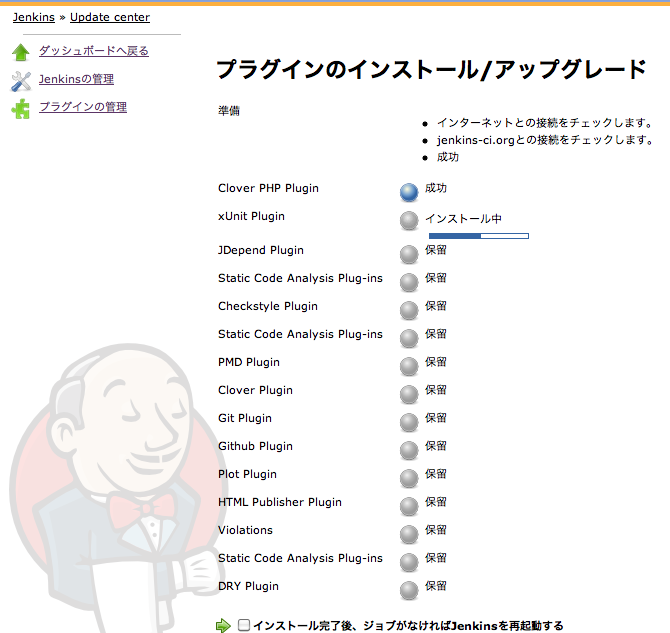
php-template のダウンロード
$ cd $JENKINS_HOME/jobs $ sudo git clone git://github.com/sebastianbergmann/php-jenkins-template.git php-template $ sudo chown -R daemon:daemon php-template/ $ sudo launchctl unload /Library/LaunchDaemons/org.jenkins-ci.plist $ sudo launchctl load /Library/LaunchDaemons/org.jenkins-ci.plist
Jenkins の再起動はとりあえず launchctl を使いまいしたが、ブラウザにある[Jenkins管理]>[設定の再読み込み]で良かったみたいです(多分)。
ちなみにコマンドラインは、ブラウザの[Jenkins管理]>[Jenkins CLI]にマニュアルがありますが、これを見る限り、safe-restart で良いのかな?
ともあれ、php-template が読み込まれました。

ジョブの作成
[新規ジョブ作成] からジョブを作成するが、今回は「既存のコピー」に 「php-template」を入力して使う。
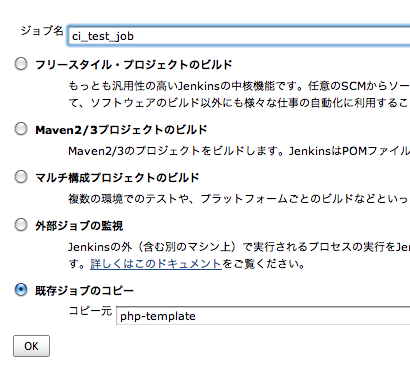
PHPUnit のインストール
実は開発でPear は全く使ってなかったので、今更ながらインストールしようと思ったら、Macports で php5-unit なるパッケージを発見したのでインストールしてみる。
sudo port install php5-unit
storyboardの詳細は、WWDC2011 セッションを参照
今回の資料
20111123STiDEV.pdf (UISctoryboard *)instantiateInitialViewController
UIStroyboardSegue
Push, Modal, Custom がある
大ざっと調べたところ、 Push は UINavigationController で利用、Modal は通常の画面遷移、Custom は カスタムクラスを作成して拡張、と言う感じに使い分けるようです。
Segueの呼び出し
(1) Storyboardだけで利用:prepareForSegue (2) プログラム上で利用:performSegueWithIdentifier
prepareForSegue:sender:
- 呼び出しもとcontroller が呼ばれる
- sender で状況判断
- segue
実際に確認しましたが、prepareForSegue は Storyboard で UIButton 等からDrag & Drop で Segue を作成し、トリガー時に呼ばれます(delegateメソッド)。
簡単に言えば、画面遷移だけなら prepareForSegue は使わずにノンプログラムで可能です。
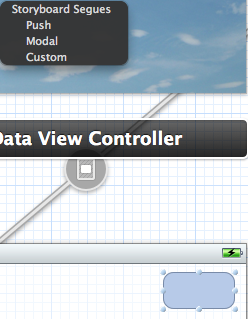 ただし次の画面にデータを受け渡す場合は、prepareForSegue を利用します。
ただし次の画面にデータを受け渡す場合は、prepareForSegue を利用します。
- (void)prepareForSegue:(UIStoryboardSegue *)segue sender:(id)sender
{
if ([[segue identifier] isEqualToString:@"showDetailSegue"]) {
DetailViewController *viewController = (DetailViewController *)[segue destinationViewController];
viewController.hoge = _hoge;
}
}
この場合ポイントは、
<
p class="code>Segue の identifier 判別 destinationViewController による UIViewController の取得
です。 まだ勉強したてなのであれですが、欠点としては Segue が増えた場合の管理が大変そうです。 Segue が存在しない場合に、try catch による Exceptionエラーは勿論、複数画面による条件処理ですね。performSegueWithIdentifier:sender:
- プログラムから遷移する場合に利用
- ボタンを作らない場合
- TableView を使う場合
実際に確認しましたが、performSegueWithIdentifier は、Styoryboard 上に Identifire 付きで Segue を作成し、プログラム上で明示的に Segue を呼び出す方法です。 プログラム上で UI を作成する場合に利用するかと思います。
[self performSegueWithIdentifier:@"Segue の Identifier" sender:self];
もっと言うと、sender:self の為、そのクラス内の prepareForSegue が呼ばれます。
iOS4 までは initWithNibName して addSubView なり presentModalViewController なりして画面遷移していたが、Storyboard と Segue を利用すれば、Storyboard で一括管理でき、上記の1行だけで画面遷移できる事でしょうか?
CustomSegue

Storyboard Segue で Style = Custom 、Segue Class に Segue クラスを設定
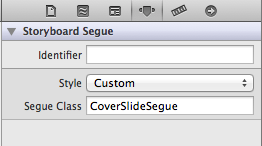 initWithIdentifire:source
initWithIdentifire:source
RelationShip
内容を別のシーン定義に - Navigation - TabBar
問題点
- 適切な、Segue がないとException ※try catch で対処
- コードに Segue を書くとダサい
Facebook や GMail っぽい UI
ViewController コンテナ 親View 子Viewの切り替えを1つの View コントローラーで実現する。
WWDC2011 Session 102 'Impleenting UIViewController Containment"
- GitHub
- 参考アプリ
didMoveToParentViewController: で切り替え - toViewが上面に来てしまう - 置換が目的で、元に戻す手順が無い - viewController の view階層は自分で管理し、open/close を自分で書く必要がある。 - addSubView でなく insertSubView を利用
Static Cells TableView
固定のテーブルビューが作成可能 - delegateメソッドを未定義にしておく - UITableView はカスタムできない
Sceneパレット
- view階層の外に置いてプログラムから利用するIBOutletを定義
User Defined Runtime Attributes
実行時に値を指定できる - KVO を利用している - Key Path でデータを設定
CI(継続的インテグレーション)ツールJenkins 何とも親切に OSX のインストーラまでついてます。
が、デフォルトだとアクセス権の問題で正常に起動できないようです。 Jenkins Mac OS X InstallerでJenkinsを入れる を参考に設定しました。
設定ファイルを確認
/Library/LaunchDaemons/org.jenkins-ci.plist
このファイルに、Jenkins のウェブルート(JENKINS_HOME )が設定されている。
JENKINS_HOME
/Users/Shared/Jenkins/Home
普通にインストール数と共有ディレクトリが指定されるが、Home ディレクトリが作成されない。
/Users/Shared/Jenkins
手動で Home ディレクトリを作成
$ cd /Users/Shared/Jenkins/ $ sudo chown daemon /Users/Shared/Jenkins/Home/ $ sudo chgrp daemon Home
デーモン再読起動
$ sudo launchctl unload /Library/LaunchDaemons/org.jenkins-ci.plist $ sudo launchctl load /Library/LaunchDaemons/org.jenkins-ci.plist
http://localhost:8080/ にアクセスすると Jenkins が表示される。
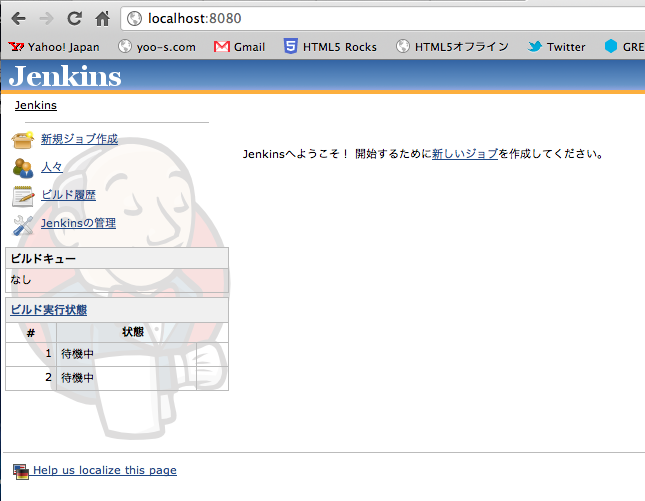
ちなみに、Jenkins を Xcode4 の UnitTest する動画があります。
NSDefault からユーザ名、パスワードが盗まれる可能性
キーチェーンに登録
UIKeyChainString を利用する
[UIKeyChainString setString: @"xxxxx" forKey:@"username"];
//サービス(ドメイン)名を指定
[UIKeyChainString setString:@"xxxxx" forKey:@"username" service: @"com.xxxxx"];
//インスタンスを利用
UIKeyChainString *store = [UIKeyChainString keyChainStoreWith];
[store removeItemForKey: @"username"];
[store synchronize]; //Write to keychain
miil のつくりかた
背景やナビゲーションを画面ごとに効率よく変える
- void drawInRect:(CGRect) rect {
[background drawAsPatternInRect: rect];
}
■UITableView のパフォーマンス - FFTimelineTitleCell - FFTimelineMoreCommentCell など、セルのカスタマイズが多い
全体の処理時間より、イベントループごとの時間を短くする事で体感的に早い場合が多い。
セルの単位を細かくしてやる
画像の表示 - UIImageView ○ - CALayer ○ - UIImage drawRect △
※最適化 png をすると drawRect が一番早い
■画面のキャッシュ - ある程度はキャッシュに持ちつ - 無ければディスクか - それでもなければネットから
キャッシュに入れるには、
NSCache(ちょっとカッコいい NSDictionary)
を利用するとよい。
■スクロールのスナップ スナップが通常に機能すると、セルが長くなった時に読めない・・・。 - 上向き、下向きのスクロールの判別 - 位置座標、移動量を判別してスナップ - 高さが1画面に満たしているかを判別
■アニメーション UIView transitionFromView, UIViewAnimationOptionShowHideTransition を利用するのが自然だった
■サムネイル UITableView を横向きに使うのが良かった ScrollView を使うのは面倒
■特定の文字のスタイルを変更する CoreText を利用するのも良いが、描画する文字を一文字ずつ処理する。
辞書アプリ Metronome Pro の作者 cocos2d for iPhone レッスンノート著者
iOS5 では辞書が標準搭載
- UITableView & UISearchBar で検索
- 意味を表示
- 候補を表示
- 辞書の選択
意味を表示
UIReferenceLibraryViewController * controller = [[UIReferenceLibraryViewController alloc] initWithFrame];
で表示させるだけ。 よって、文字を取得する事はできない。
候補を表示
UITextChecker *_cheker = [[UITextCheker alloc] init];
guessesForWordRange:NSMakeRange(0, [searchText length])
inString: searchText
language: ["en_US"];
[UIReferenceLibraryViewController dictionaryHasDefinitinoForTerm: searchText];
辞書の選択
NSLocale の +(NSArray *)prefferedLanguage をオーバーライド
[[NSArray arrayWithObject: @"en"];
iPad とレシートプリンタを繋ぎたい。 (AirPlay があるのにあえて使ってみる!)
ポスレジを iPad と レシートプリンタで実現するデモ・・・感動ものでした。。。
プリンタ機種
EPSON TM-T70 ・RS-232C(シリアルポート) ・IEEE1284(パラレル) ・USB20 ・100(10)BASE-TX ・無線LAN(IEEE802.11b)インターフェイス
iPad側のインターフェイス
・GKSession で Bluetooth、NetWork接続 ・NSStream経由でNetWork接続
GKSessionは、同一アプリからしか通信できない
NSStream しかない
NSStream
メモリ、ファイル、ネットワーク(ソケットを通じて)に配置されたデータのストリームオブジェクトを作る事ができる。
EPSON TM-T70
■RS232 etherNet Converter シリアル通信をイーサーネット上のソケット通信に変換するコンバータ
TCP、UDP、UART が利用できる。 ※UART シリアル通信を制御するチップ
カスタマディスプレイ(2行表示)では見づらいので、
iPad でディスプレイ表示!
実装部分
- NSStreamDelegate 利用
- CFStreamCreatePairWithSocketToHost
- ポート番号9100番を指定
char s[3];
s[0] = 0x1b;
[_outputStream write:(unit8_t*)s max Length:sizeof(s)];
- Shift-JIS のロムを持っているので、NSShiftJISSStreingENcoding を利用
- サーバを置かなくても、LPRプロトコルを使って通信可能
実演
- メインディスプレイは、ONKYO の フォトビューワー(製造中止w) ※AppleTV 経由で表示も可能
- 商品一覧、金額は基本プログラム
- デザイン部分は、WebView で表示
iPad 側の機能
- 顧客マスター
- 担当マスター
- 店舗マスター
- 消費税率
- 支払い方法
- 売上げ管理(釣り銭準備金、回収、雑収入など)
CMLocationManager
iPhone アプリのコンパスでは、iPhone を縦に傾けると方角が180度変わってしまうポイントがある。 地磁気と加速度からデバイスの向きを考慮した方角を算出 参考資料
OpenGL + 加速度センサで のグラフィックをそのまま表示(ARぽく)するとかなり震える。 加速度の値をそのまま使うとばらつきがある為、安定しない。
ローパスフィルターの適応して位置補正やる
ここら辺は大学の制御工学でやった気がするが、今の自分にはもうそんな学力はない訳で・・・。
CMMotionManager
またジャイロセンサー(CMRotationRate の値)を使うといい感じで補正できる。
バッテリーの問題
Energy Diagnostics で 60秒間計測 iPhone 4 iOS4.3.3
■アプリ起動のみ Energy Usage: 9/20
■方角取得のみ Energy Usage: 11/20
■加速度 + ジャイロのみ Energy Usage: 18/20
■OpenGL描画 動作周波数:30Hz 超点数:14000 Energy Usage: 16/20 20%
■すべて使用 Energy Usage: 18/20 CPU Activity:85%
■iPhone 標準カメラ Energy Usage: 18/20 CPU Activity:85%
Foursquare iOS API
PHPフレームワーク FuelPHP が話題になったのでインストールしてみた。
詳しい記事は、PHP フレームワークの「FuelPHP」がスゴすぎる を参照に。
- ORM、マイグレート対応しており、MongoDB、Redis も使えるとの事
- 基本的にスタティックにコーディングするので(インスタンスを経由ラッパーしていると思う)ので書くコードが少なそう
- Unitテスト(PHPUnit、Jenkins)対応
- autoload 対応でライブラリ、ヘルパーの自動ロードができる
- Scaffolding 対応(oilコマンド)
- 多数のViewテンプレート対応
会社では独自フレームワークを使って、更にDBと連動してアプリ作成自動化を進めてますが、一人よがりなんですよね。 比較してみて良さげだったら切り替えようかと・・・
PHP フレームワークとして評価が高い「Codeigniter」の対抗として注目されているみたいです。
oil のインストール
RoR みたいにプロジェクトを作成するのに oil コマンドが必要なのでインストール
$ curl get.fuelphp.com/oil | sh % Total % Received % Xferd Average Speed Time Time Time Current Dload Upload Total Spent Left Speed 100 244 100 244 0 0 705 0 --:--:-- --:--:-- --:--:-- 1410 password:
パスワードを聞かれるのは、/usr/bin にコマンドをいれるかららしい。
プロジェクト作成
$ cd Sites/ $ oil create blog Cloning into ./FuelTest... remote: Counting objects: 14115, done. remote: Compressing objects: 100% (4842/4842), done. remote: Total 14115 (delta 9635), reused 13321 (delta 9041) Receiving objects: 100% (14115/14115), 2.06 MiB | 666 KiB/s, done. Resolving deltas: 100% (9635/9635), done. Submodule 'docs' (git://github.com/fuel/docs.git) registered for path 'docs' ... Made writable: /Users/yoo/Sites/FuelTest/fuel/app/cache Made writable: /Users/yoo/Sites/FuelTest/fuel/app/logs Made writable: /Users/yoo/Sites/FuelTest/fuel/app/tmp Made writable: /Users/yoo/Sites/FuelTest/fuel/app/config
パーミッションを手動で変えたい場合は、
php oil refine install Made writable: /Users/yoo/Sites/FuelTest/fuel/app/cache Made writable: /Users/yoo/Sites/FuelTest/fuel/app/logs Made writable: /Users/yoo/Sites/FuelTest/fuel/app/tmp Made writable: /Users/yoo/Sites/FuelTest/fuel/app/config
public を Web ルートに
デフォルトだと、Webルートがプロジェクトディレクトリになってしまうので public を Webルートに設定する必要がある。 Appache の設定で、public をWebルートにするか、.htaccess で public/ へ rewirte 設定してやる。
Options -MultiViews
RewriteEngine on
RewriteRule (.*) public/$1 [L]
ファイル構成
.git .gitmodules README.md docs/ oil .gitignore CHANGELOG.md TESTING.md fuel/ public/
デフォルトだと、Git 管理される。 public/ fuel/ ディレクトリだけの構成 oil は拡張子こそないがPHPファイル(PHPコマンドで使うのかな?)
fuel/
app/ core/ packages/
RoR のような構成とはちょっと違うが、名前から大体想像がつくと思います。
fuel/app/
bootstrap.php classes/ config/ lang/ logs/ migrations/ modules/ tasks/ tmp/ views/
こう見ると、たくさんの機能がサポートされてる臭いがします。 config/ では、アプリの一般設定やDB設定ファイルがあり、開発/デプロイと分ける事が可能。 ローカライズ(デフォルト en)、XSS対応、cookie、モジュール管理、パスのルーティングなどなど多彩な設定が用意されています。
classes/ では
controller model view
といった、アプリ作成でお馴染みの顔ぶれが。 ただ、fuel/views というディレクトリもあるので使い分けは不明だが、テンプレート自体は app/views に HTML を記述するっぽい。 classes/view は、HTMLレンダリングする前にパラメータを変えたりヘルパー的な事を記述するような気がする。
public/
.htaccess assets/ index.php
.htaccess でリライトして、index.php が最初に読み込まれます。
/**
* Set error reporting and display errors settings. You will want to change these when in production.
*/
error_reporting(-1);
ini_set('display_errors', 1);
/**
* Website document root
*/
define('DOCROOT', __DIR__.DIRECTORY_SEPARATOR);
/**
* Path to the application directory.
*/
define('APPPATH', realpath(__DIR__.'/../fuel/app/').DIRECTORY_SEPARATOR);
/**
* Path to the default packages directory.
*/
define('PKGPATH', realpath(__DIR__.'/../fuel/packages/').DIRECTORY_SEPARATOR);
/**
* The path to the framework core.
*/
define('COREPATH', realpath(__DIR__.'/../fuel/core/').DIRECTORY_SEPARATOR);
// Get the start time and memory for use later
defined('FUEL_START_TIME') or define('FUEL_START_TIME', microtime(true));
defined('FUEL_START_MEM') or define('FUEL_START_MEM', memory_get_usage());
// Boot the app
require APPPATH.'bootstrap.php';
// Generate the request, execute it and send the output.
try
{
$response = Request::forge()->execute()->response();
}
catch (HttpNotFoundException $e)
{
$route = array_key_exists('_404_', Router::$routes) ? Router::$routes['_404_']->translation : Config::get('routes._404_');
if ($route)
{
$response = Request::forge($route)->execute()->response();
}
else
{
throw $e;
}
}
// This will add the execution time and memory usage to the output.
// Comment this out if you don't use it.
$bm = Profiler::app_total();
$response->body(
str_replace(
array('{exec_time}', '{mem_usage}'),
array(round($bm[0], 4), round($bm[1] / pow(1024, 2), 3)),
$response->body()
)
);
$response->send(true);
// Fire off the shutdown event
Event::shutdown();
DOCROOT : doc パス登録 APPPATH : fuel/app パス登録 PKGPATH : fuel/package パス登録 COREPATH : fuel/core パス登録 FUEL_START_TIME : fuelphp 開始時間登録 FUEL_START_MEM : fuelphp メモリ容量登録
bootstrap.php で app のメインファイルを起動し、autoloader.php でオートロード(必ず読み込むファイル)等を管理しています。 CodeIgniter だと手動で書かなければいかない点が、FuelPHP では自動ロード可能って事ですね。
最後に、config.php を読み込んでいます。
コントローラーとビューの作成
■ビューファイル app/views/inquiry/index.php
普通にHTMLファイルを記述 レイアウトの分け方は現在不明
■コントローラーファイル app/inquiry.php
class Controller_Inquiry extends Controller
{
/**
* The basic welcome message
*
* @access public
* @return Response
*/
public function action_index()
{
return Response::forge(View::forge('inquiry/index'));
}
/**
* show how to use them.
*
* @access public
* @return Response
*/
public function action_send()
{
}
}
- クラス名は、Controller_コントローラ名(最初は大文字)
- デフォルトは Controller を継承
- ビューレンダリングは Response::forge() ,View::forge() を利用
- Fuel独自の関数 new static を実装しており、静的メソッドで書く事が可能
Response 、Viewで使える関数は、fuel/core/classes/response.php ,view.php を参照するとよいかと。 ちなみに Viewに関しては、forge(), render(), factory() といった数種類の方法がある。
ただアクション名とファイル名が一致したら、レンダリングの記述は省いて自動レンダリングしてくれる機能は欲しいところです
Codeigniter の対抗になるか?
Codeigniter vs FuelPHP でも比較検討の記事が掲載。
FuelPHP は機能は良いけど、新しい機能への弊害や利用者数の少なさが問題のようですね。
WebGL の記事でちょっとだけ書いたんですけど、世の中に少しずつ作品が紹介されてるのを目にしますね。 Twitter で #webgl でリアルアイムでかなり頻繁に情報が飛び交ってます。
Ellie Goulding Lights
Ellie Goulding Lights VJ ですね!
Cérebro 3D em WebGL
Cérebro 3D em WebGL 脳のグラフィック表示
ThreeNodes.js
ThreeNodes.js モデル作成ツール? JSON で書き出せますが、用途不明。
Github でもソースが公開されています。 Github ThreeNodes.js
WebGL の基本
Hack The WebGL (WebGL勉強会) 日本だとここの勉強会が活発なんでしょうか? Hello World 的なサンプルもあります。
■glMatrix glMatrix ってのを使ってるらしいですが、glMatrix.js はイケてない て記事もあったり。。。 この表を見る限りライブラリーが乱立していてなかなか手が出しづらいですが、まずは 基本的な扱いを覚えないとです(汗)
iOS5 から AudioToolbox に MusicPlayer が追加された。 ※間違いが含まれている場合があるので注意
/*!
@header MusicPlayer.h
@abstract API for Music sequencing and playing services
@discussion
Basic idea behind the Sequencing Services APIs:
A MusicSequence contains an arbitrary number of tracks (MusicTrack)
each of which contains time-stamped (in units of beats) events in time-increasing order.
There are various types of events, defined below, including the expected MIDI events, tempo,
and extended events.
A MusicTrack has properties which may be inspected and assigned, including support
for looping, muting/soloing, and time-stamp interpretation. APIs exist for iterating through the
events in a MusicTrack, and for performing editing operations on them.
A MusicPlayer is used to play a sequence and provides control of playback rate and
setting to a particular time.
Each MusicSequence may have an associated AUGraph object, which represents a set
of AudioUnits and the connections between them. Then, each MusicTrack of the
MusicSequence may address its events to a specific AudioUnit within the AUGraph.
In such a manner, it's possible to automate arbitrary parameters of AudioUnits,
and schedule notes to be played to MusicDevices (AudioUnit software synthesizers)
within an arbitrary audio processing network (AUGraph). A MusicSequence or its tracks
can also address a MIDI endpoint directly.
The objects defined in this header are:
Music Sequence - container of music tracks
Music Track - a time ordered list of events
Music Track Iterator - an object to iterate over events in a track
Music Player - an object used to play a sequence
*/
シーケンスと演奏サービスのAPI と思いっきり明記されています。 ビート単位に関するタイムスタンプで、任意のトラックで利用可能。 ループ、ミュート、ソロ、タイムスタンプ解像度(?)をサポート。 再生レートコントロール、特定の時間設定が可能。 シーケンサーは、AUGraph オブジェクトに関連しており、AudioUnitsと連携する。
シーケンストラックは、AUGraph を含む 特定の AudioUnit イベントを対処する。 これで、AudioUnits の任意パラメータを自動化することはできる。 ノートをスケジュールすることで、任意のオーディオプロセスを含む MusicDevices(AudioUnit ソフトシンセ)を再生する事ができる
MusicSequence もしくはトラックは、MIDIエンドポイントを直接対処することができる。 - Music Sequence - MusicTrackを含む - Music Track - イベントリストのオーダー時間 - Music Track Iterator - トラック内のイベントを Iterate するオブジェクト - Music Player - シーケンス再生で使われるオブジェクト
include
#include
#include
#include
#include
#include
ざっと見て、 - MIDIServices.h で シーケンスを利用できる - AUGraph.h で フィルタを利用でき、Instrument(いわゆるソフトシンセ)とも連動できる と捉えてよいのだろうか?
■MusicEventType 〜 AUPresetEvent
MusicEventType
/*!
@enum MusicEventType
@abstract music event types, including both MIDI and "extended" protocol
@constant kMusicEventType_NULL
@constant kMusicEventType_ExtendedNote note with variable number of arguments (non-MIDI)
@constant kMusicEventType_ExtendedTempo tempo change in BPM
@constant kMusicEventType_User user defined data
@constant kMusicEventType_Meta standard MIDI file meta event
@constant kMusicEventType_MIDINoteMessage MIDI note-on with duration (for note-off)
@constant kMusicEventType_MIDIChannelMessage MIDI channel messages (other than note-on/off)
@constant kMusicEventType_MIDIRawData for MIDI system exclusive data
@constant kMusicEventType_Parameter, general purpose AudioUnit parameter, added in 10.2
@constant kMusicEventType_AUPreset, the AU's user preset CFDictionaryRef (the ClassInfo property), added 10.3
*/
enum
{
kMusicEventType_NULL = 0,
kMusicEventType_ExtendedNote = 1,
kMusicEventType_ExtendedTempo = 3,
kMusicEventType_User = 4,
kMusicEventType_Meta = 5,
kMusicEventType_MIDINoteMessage = 6,
kMusicEventType_MIDIChannelMessage = 7,
kMusicEventType_MIDIRawData = 8,
kMusicEventType_Parameter = 9,
kMusicEventType_AUPreset = 10
};
typedef UInt32 MusicEventType;
ノート、チャンネル、テンポ、メタといったタイプがある。
MusicSequenceLoadFlags
/*!
@enum MusicSequenceLoadFlags
@abstract Flags used to customise loading behaviour
@constant kMusicSequenceLoadSMF_ChannelsToTracks
If this flag is set the resultant Sequence will contain:
a tempo track
1 track for each MIDI Channel that is found in the SMF
1 track for SysEx or MetaEvents - this will be the last track
in the sequence after the LoadSMFWithFlags calls
*/
enum
{
kMusicSequenceLoadSMF_ChannelsToTracks = (1 << 0)
};
typedef UInt32 MusicSequenceLoadFlags;
SMFファイル読み込み時のフラグ フラグがセットされていたら、テンポトラックを1トラックに設定(?)
MusicSequenceType
/*!
@enum MusicSequenceType
@abstract A sequence type
@discussion Different sequence types to describe the basic mode of operation of a sequence's time line
You cannot change a music sequence's type to samples/seconds if there are tempo events
The type will also define how the sequence is saved to a MIDI file:
Beats - normal midi file
Seconds - midi file with SMPTE time
Samples - cannot be saved to a midi file
@constant kMusicSequenceType_Beats
The default/normal type of a sequence.
Tempo track defines the number of beats per second and can have multiple tempo events
@constant kMusicSequenceType_Seconds
A music sequence with a single 60bpm tempo event
@constant kMusicSequenceType_Samples
A music sequence with a single tempo event that represents the audio sample rate
*/
enum {
kMusicSequenceType_Beats = 'beat',
kMusicSequenceType_Seconds = 'secs',
kMusicSequenceType_Samples = 'samp'
};
typedef UInt32 MusicSequenceType;
ミュージックシーケンスタイプ - Beats - 通常のMIDIファイル - Seconds - SMPTE の MIDIファイル - Samples - MIDIファイルに保存できない
MusicSequenceFileTypeID
/*!
@enum MusicSequenceFileTypeID
@abstract describes different types of files that can be parsed by a music sequence
@constant kMusicSequenceFile_MIDIType
read and write MIDI files
@constant kMusicSequenceFile_iMelodyType
read iMelody files
*/
enum {
kMusicSequenceFile_MIDIType = 'midi',
kMusicSequenceFile_iMelodyType = 'imel'
};
typedef UInt32 MusicSequenceFileTypeID;
ミュージックシーケンスファイルタイプ - kMusicSequenceFile_MIDIType - MIDIファイル読み書き - kMusicSequenceFile_iMelodyType - iMelody ファイル読み書き
通常は、kMusicSequenceFile_MIDIType で大丈夫かと
MusicSequenceFileFlags
/*!
@enum MusicSequenceFileFlags
@abstract controls the behaviour of the create file calls
@constant kMusicSequenceFileFlags_EraseFile
Erase an existing file when creating a new file
*/
enum {
kMusicSequenceFileFlags_EraseFile = 1
};
typedef UInt32 MusicSequenceFileFlags;
現在、 kMusicSequenceFileFlags_EraseFile しかない。 新規作成ファイル時に、ファイルが存在したら消す
MusicTimeStamp
/*!
@typedef MusicTimeStamp
@abstract The type used to refer to time values in a music sequence
*/
typedef Float64 MusicTimeStamp;
シーケンス時のタイムスタンプで、時間指定の基本の型です。
MIDINoteMessage
/*!
@struct MIDINoteMessage
@discussion The parameters to specify a MIDI note
*/
typedef struct MIDINoteMessage
{
UInt8 channel;
UInt8 note;
UInt8 velocity;
UInt8 releaseVelocity; // was "reserved". 0 is the correct value when you don't know.
Float32 duration;
} MIDINoteMessage;
MIDI ノートのパラメーター(UInt8)で、チャンネル、ノート、ベロシティ、リリースベロシティ、デュレーションがある。
MIDIChannelMessage
/*!
@struct MIDIChannelMessage
@discussion The parameters to specify a MIDI channel message
*/
typedef struct MIDIChannelMessage
{
UInt8 status; // contains message and channel
// message specific data
UInt8 data1;
UInt8 data2;
UInt8 reserved;
} MIDIChannelMessage;
MIDIチャンネルメッセージのパラメータ(UInt8)で、ステータス(メッセージとチャンネル)、データ1、データ2、予約がある。
MIDIRawData
/*!
@struct MIDIRawData
@discussion Generally used to represent a MIDI SysEx message
*/
typedef struct MIDIRawData
{
UInt32 length;
UInt8 data[1];
} MIDIRawData;
MIDI生データで、エクスクルーシブメッセージとして利用
MIDIMetaEvent
/*!
@struct MIDIMetaEvent
@discussion The parameters to specify a MIDI meta event
*/
typedef struct MIDIMetaEvent
{
UInt8 metaEventType;
UInt8 unused1;
UInt8 unused2;
UInt8 unused3;
UInt32 dataLength;
UInt8 data[1];
} MIDIMetaEvent;
MIDIメタデータ MIDIメタデータのパラメータは、metaEventType(UInt8)、未使用1〜3(UInt8)、データ長(UInt32)、データ[1](UInt8)がある。 (これはMIDIデータの生の構造かと)
MusicEventUserData
/*!
@struct MusicEventUserData
@discussion Provides a general struct for specifying a user defined event.
@field length
the size in bytes of the data
@field data
size bytes of user defined event data
*/
typedef struct MusicEventUserData
{
UInt32 length;
UInt8 data[1];
} MusicEventUserData;
開発者が独自に定義できるユーザデータイベントパラメータ(構造体)
ExtendedNoteOnEvent
/*!
@struct ExtendedNoteOnEvent
@discussion The parameters to specify an extended note on event
*/
typedef struct ExtendedNoteOnEvent
{
MusicDeviceInstrumentID instrumentID;
MusicDeviceGroupID groupID;
Float32 duration;
MusicDeviceNoteParams extendedParams;
} ExtendedNoteOnEvent;
拡張用ノートイベントで音色ID、グループID、デュレーション、拡張パラメータ 拡張データの規格に対応していれば、利用できる? MusicDeviceInstrumentID 、MusicDeviceGroupID で MusicDevice を振り分けられる?
ParameterEvent
/*!
@struct ParameterEvent
@discussion The parameters to specify a parameter event to an audio unit.
*/
typedef struct ParameterEvent
{
AudioUnitParameterID parameterID;
AudioUnitScope scope;
AudioUnitElement element;
AudioUnitParameterValue value;
} ParameterEvent;
AudioUnit 用の特殊イベントパラメータ(構造体) AudioUnit のパラメータがよくわかっていないので、何とも・・・
- AudioUnitParameterID - filter cut-off frequency がある
- AudioUnitScope - 0 〜 1024 の AudioUnit スコープ で、global, input, output がある
- AudioUnitElement - スコープは1つ以上のメンバーを持ち、Elementによって関連づけられる。 input bus 1 は 入力スコープ
- AudioUnitParameterValue - AudioUnit パラメータ値
これは、iPhone Core Audio の本を読み直しですね。。。 ■参考 スコープについて
ExtendedTempoEvent
/*!
@struct ExtendedTempoEvent
@discussion specifies the value for a tempo in beats per minute
*/
typedef struct ExtendedTempoEvent
{
Float64 bpm;
} ExtendedTempoEvent;
テンポイベント(30〜250くらい)で、bpm(Float64) が利用可能
AUPresetEvent
/*!
@struct AUPresetEvent
@discussion The parameters to specify a preset for an audio unit.
*/
typedef struct AUPresetEvent
{
AudioUnitScope scope;
AudioUnitElement element;
CFPropertyListRef preset;
} AUPresetEvent;
AudioUnit用の、特殊プリセットパラメータ(構造体)
これも、AudioUnit のパラメータがよくわからないので・・・ シーケンスするときにサンプル音と連動する。
















